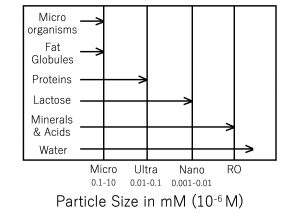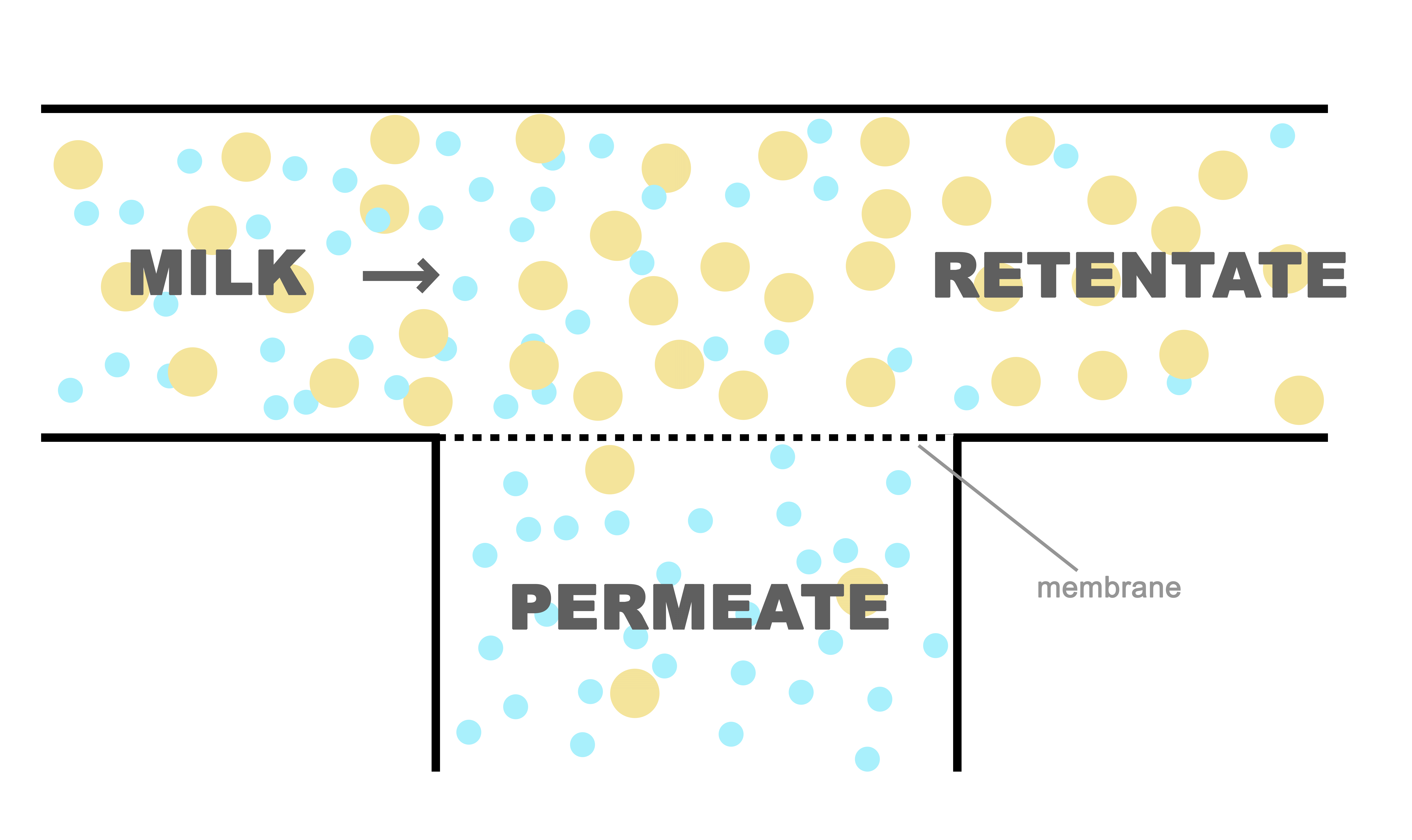Some Alternate Technologies
24 Cheese Making from Ultra-filtered Milk
1. Terms and Principles
Milk has a wide range of components with different functionalities, including foamability, emulsification, shelf life extension, health benefits, nutrient source for fermentation, fat replacement, etc. In addition, milk processing results in different byproducts that might require further processing before being marketed. Several methods are used to concentrate and separate milk components.
Figure 24.1. shows the separation of milk components by the use of different membranes processes.

Reverse Osmosis (RO): RO is a pressure driven process where small molecules (molecular weight less than 100 daltons, e.g., water) are separated from larger molecules by a semi-permeable membrane. In practice, the term describes a concentration process where water is removed to increase total solids content of a liquid. For example, desalination can be accomplished using RO. It is appropriate to think of RO and the related membrane processes, ultrafiltration and nanofiltration, as chemical filters where the separation characteristics are determined by the pore size of the membrane and the chemical interactions between the product and the membrane. The most common RO membrane material is cellulose acetate with an operating pH of 5 to 7. Dairy applications include supplementation of milk evaporators, whey concentration, and waste treatment.
Nanofiltration (NF): NF is a membrane process with separation characteristics intermediate between RO and UF. It is designed to separate small minerals and ions from larger molecules such as sugars. It is used to demineralize cheese whey as an alternative to ion exchange and electro dialysis.
Ultrafiltration (UF): UF is a membrane process where semi-permeable membranes are used to separate large molecules (molecular weight greater than 10,000), such as proteins, from small molecules, such as sugars. Common membrane materials are polysulfone (operating pH 2 to 12) and ceramic (pH 2 to 12, retort sterilisable). UF is commonly used to obtained Milk Protein Concentrates and Whey Protein Concentrates. It can also be used to concentrate milk proteins and fat, where the permeate is mainly water, lactose, and some minerals.
Microfiltration (MF): MF is a membrane filtration process designed to separate particles greater than 0.2 μM. Principal dairy applications are spore removal from milk to prevent late gas defect in cheese and to extend the shelf life of pasteurized milk. You can see examples of this in the grocery store shelf, where this product is sold as microfiltered milk. Modern MF membranes can also be used to separate casein micelles in milk from whey proteins. This, makes it possible to produce precheese with varying rations of casein: whey protein, and also to produce pure micellar casein and pure native whey proteins.
Permeate and Retentate: Material passing through the membrane is called permeate, while material retained by the membrane is retentate. For example, UF milk permeate is composed of water, sugar, some minerals and non-protein nitrogen compounds. UF retentate is a concentrate of milk fat and protein, including both caseins and whey proteins.

Component Processing: Developments in membrane processing combined with other conventional and emerging technologies make it possible to isolate and recombine milk components in new ways to produce new products, process conventional products more efficiently, or reduce waste. As mentioned above, these products include native whey proteins and micellar caseinates.
2. Properties of UF Milk Retentates
Composition: UF retains all milk fat and protein. Lactose permeates freely through the membrane. Mineral retention is dependent on the association with proteins and decreases with acidification.
Physical Properties: Fat globules are slightly reduced in size, indicating that some homogenization takes place in the UF system. Casein micelles and whey proteins are mostly unaltered. Buffer capacity of UF retentates increases exponentially with total solids due to the concentration of proteins and salts.
Lactic Fermentation: Culture growth is normal but more acidity is required to reduce pH because of the high buffer capacity of UF milk retentate.
Rennet Coagulation: If rennet is added proportional to milk volume rather than weight of protein, rennet coagulation time (RCT) is unaffected by UF concentration. This means that, relative to the amount of protein present, less rennet is required for coagulation. However, the structure and properties of the gel are quite different than in normal milk, and for aged cheese there is insufficient rennet to promote ripening. Further, concentration by UF has the remarkable effect of restoring rennetability to over-pasteurized milk. The resulting curd can be used for making soft ripened cheese, but not for other predominantly rennet coagulated varieties.
Milk Quality: UF activates the natural milk lipase and concentrates bacteria. However, UF retentates have superior freeze-thaw stability, less oxidative rancidity, and greater microbiological stability.
3. Development of UF Applications in the Cheese Industry
MMV Process: MMV stands for Maubois Macquat Vassal process[1]. Method: Concentrate to 5-7 x original milk protein content, add both starter and rennet, incubate until both coagulation and lactic fermentation are complete, and ripen. MMV is most successful for some fresh and soft-ripened cheese varieties which have relatively low total solids and do not require rigorous pH control. It has been most successful for Feta cheese. The MMV process produces close textured cheese, which has led to two types of Feta: (1) Structured or conventional Feta; and (2) UF or cast Feta. The MMV process can also be used to manufacture cheese base to extend young Cheddar in process cheese formulations. The amount of UF retentate in process cheese products is limited by the presence of whey protein in the retentate which impairs meltability of the cheese.
The LCR Process: LCR stands for low concentrated retentate. Milk is concentrated 1.5 – 2 x original milk protein content. Cheese is made using minor modifications to traditional procedures. LCR is now the principal process used in French Camembert providing the advantages of slightly higher yields, labour savings, facilitation of continuous cheese making, and increased plant capacity. Most types of hard cheese have been made by LCR principles, generally with minimal success.
UF retentates in the mid-range of concentration (2 – 5 x original protein content) have not been successful with the exception of Feta. It is possible to produce higher yields of Feta than via conventional means by heat treating retentate at sufficient levels to denature whey proteins. Normally, this would impair rennet function, but UF treatment restores rennetability. The result is that denatured whey proteins are incorporated into the rennet gel, thus increasing cheese yield. This permits manufacture of a structured Feta, similar to traditional products, while realizing significant yield improvement. This practice has been successful for Feta but not for most rennet cheese because the whey proteins impair meltability and produce a coarse textured cheese.
Table 24.1: Ultra filtration of whole milk: typical composition of concentrate and permeate. System: polysulfone membrane in tubular configuration), small pilot plant, batch operation at operation at 50°C
| Concentration factor | Total solids | Fat (%) | Protein (%) | NPN (%) | Lactose (%) | Ash (%) |
| x1 | 12.9 | 3.9 | 3.1 | 0.18 | 4.7 | 0.77 |
| 3 | 28.6 | 12.6 | 9.8 | 0.18 | 4.1 | 1.3 |
| 5 | 43.3 | 21.8 | 16.1 | 0.18 | 3.2 | 1.9 |
| Permeate | ||||||
| x1 | 5.7 | 0 | <0.01 | 0.18 | 4.8 | 0.53 |
| 3 | 6.1 | 0 | 0.06 | 0.19 | 5.1 | 0.53 |
| 5 | 6.7 | 0 | 0.49 | 0.19 | 5.2 | 0.54 |
- (Maubois et al., 1969) ↵

